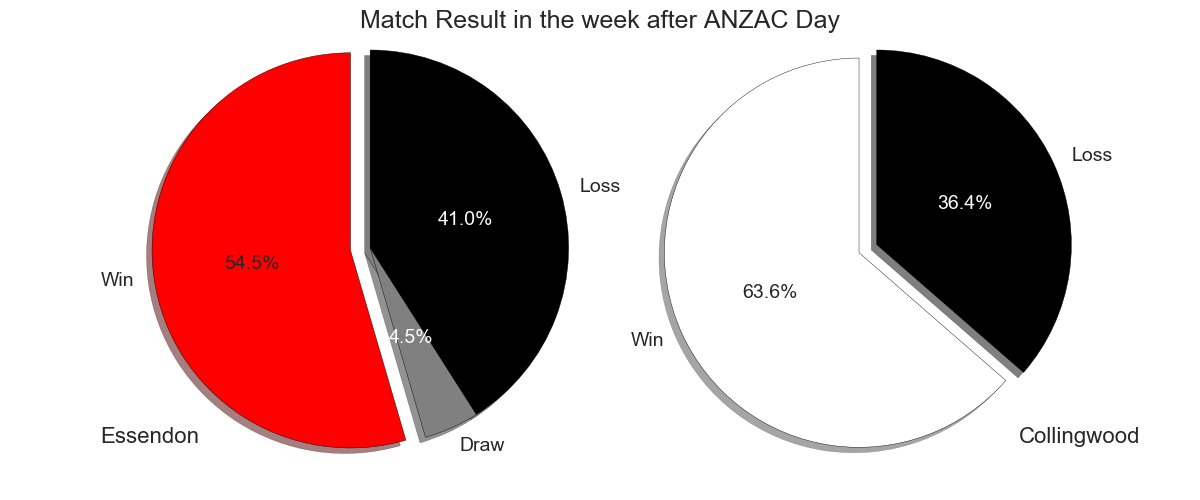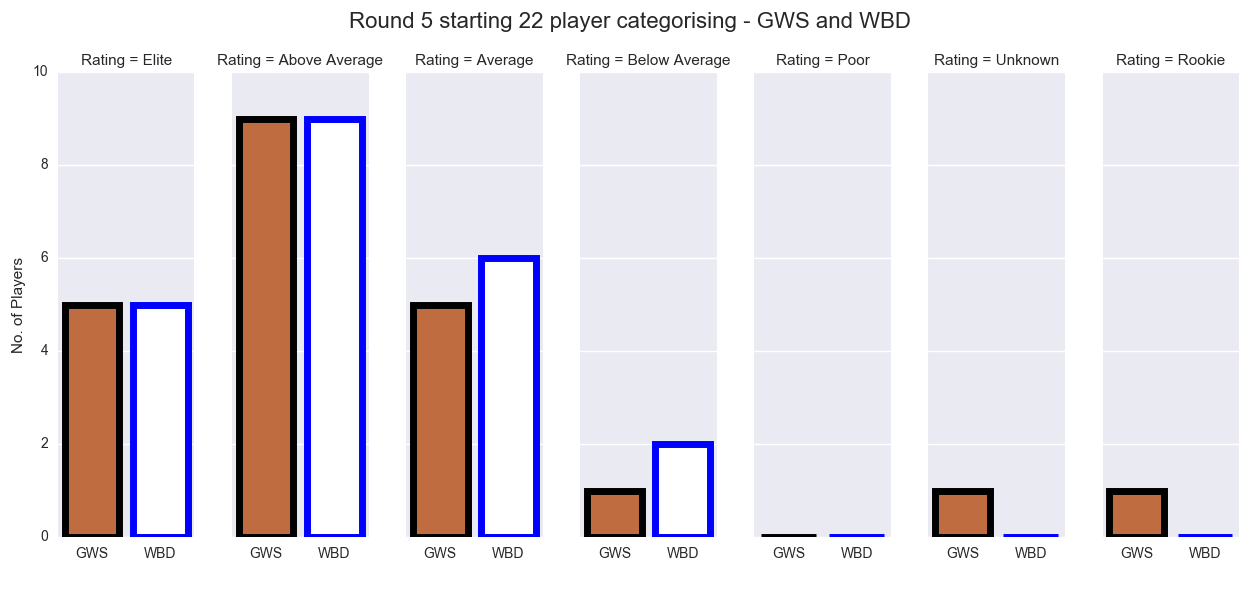AFL Round 5: Essendon vs. Collingwood (ANZAC Day Clash)
Tuesday Afternoon, 25th April 2017 at the MCG
----------
The ANZAC Day clash has become an iconic event in Australian Sport. The inaugural Essendon versus Collingwood ANZAC Day clash in 1995 is the foundation from which the event has built this elevated status. That first match certainly drew upon the sense of occasion that ANZAC Day provided and the enormous crowd of 94,823 certainly played its part. However, the success of the match and what the ANZAC Day clash has gone on to become is due to the two teams that day delivering us one of the all time classic matches.
Based on the monopoly, fairly or unfairly, Essendon and Collingwood have had on the ANZAC Day feature game, you could be forgiven for thinking that it has always been this way. However, that is most certainly not the case, as football on ANZAC Day has been a common occurrence since 1960 and in some cases entire rounds of football were played on ANZAC Day when it fell on a Saturday (1964, 1970 and 1981). In fact neither Essendon nor Collingwood were a regular fixture on ANZAC Day prior to 1995. So what contributed to the success of the 1995 ANZAC Day clash compared to what had come before it? Firstly, it was a standalone fixture on a Tuesday. Up until 1994, if football was played on ANZAC Day it was with multiple fixtures. So with the public holiday falling on a weekday and the only game on show, the match at the MCG took centre stage. Secondly, and perhaps more crucially the 1995 ANZAC Day clash was fully supported by the RSL, providing the match the official recognition it had previously lacked. By coincidence, the Victorian RSL chief at the time, Bruce Ruxton, was a passionate Collingwood supporter.
But the acknowledged brainchild of the 1995 ANZAC Day clash was Essendon coach Kevin Sheedy. Kevin Sheedy was apparently inspired by the 1977 ANZAC Day match between Richmond and Collingwood. Up until 1995, this match was considered the biggest ANZAC Day match ever played. 92,436 people attended that Monday afternoon at the MCG with the Magpies winning by 26 points. This match coincided with the Magpies coach Tom Hafey facing his former club for the first time, a club for which he had led to 4 premierships and left in acrimony at the end of 1976. So this could have been a factor in the big crowd. Regardless, Sheedy saw the potential for a blockbuster on ANZAC Day and he contacted his friend Graeme Allan, the Collingwood football manager, and together with Bruce Ruxton and the club presidents Allan McAlister and David Shaw, planned what would soon become the first of a traditional ANZAC Day blockbuster [1].
With the support of the RSL and the hype building up to the Tuesday game, the MCG became a part of the ANZAC Day itinerary – the solemn dawn service, the march of the veterans and then the rush to the MCG. 94,823 people got into the stadium (the second-highest attendance for a VFL/AFL home-and-away match in history), whilst 20,000 by some estimates were turned away and dispersed by mounted police.
With the stage set, thankfully the match itself lived up to expectation. The highlights reel provides a strong dose of nostalgia. The Paul Williams dash and long kicking. The silky skills of Mark Mercuri. The elasticity of Gavin Wanganeen. The Dermott Brereton antics. The Mick McGuane run and carry. The Che Cockatoo-Collins goal sense. The Saverio Rocca contested marking. The polish of James Hird in the big moments. As well as the possession accumulation of a young Nathan Buckley (he would go on to receive the 3 Brownlow Medal votes). But it was Saverio Rocca that stole the show, kicking 9.2, including the goal to tie the scores with a minute remaining (I would also love to know what Michael Long was whispering into his ear when lining up for goal). Rocca himself reflected that that's probably the best game that I've been involved in. Indeed his contribution was a worthy match-winning performance, except Collingwood didn’t win. But nor did they lose, the match fittingly finishing in a draw and entering into football folklore as one of the greatest games in the history of the AFL. On April 25 1995, an old rivalry was renewed and the ANZAC Day clash legacy was born.
----------
Twenty-two years later and Collingwood has a comfortable lead in the head-to-head count for the ANZAC Day clash, with 13 wins to 8 and 1 draw. Collingwood have been particularly dominant over the past decade as indicated in Figure-1.
Figure-1: Historical ANZAC Day Clash Results
One similarity between the inaugural ANZAC Day clash and the 2017 edition is that the game will be played on a Tuesday. A quirk of playing on a fixed day in the calendar means from year to year the day of the week of the game changes. In some years, the teams have a short back-up from the previous round into playing on a Wednesday or Thursday followed by a long break until the next round. In other years, like 2017, they have a long break into an ANZAC Day clash on a Monday or Tuesday, followed by a short back-up into the next round. With all the emotional energy that goes into an ANZAC Day game coupled with a short back-up into the next round, surely both teams would be expected to underperform in the next match. The stats suggest differently. Since the start of 1995, both teams have an overall match winning record of 51%. In the match immediately following ANZAC Day, Essendon have had a win record of 55% and Collingwood 64% as summarised in Figure-2. In particular their recent records have been particularly impressive. Although in 2016 they both lost, both teams could be forgiven, Essendon were in their sabbatical year with their missing stars and Collingwood had a trip to Subiaco to face West Coast. However, prior to 2016, Collingwood had won in the week after ANZAC Day in 7 consecutive years, whilst Essendon for 6 consecutive years. An impressive track record.
Figure-2: Match Result in the week after ANZAZ Day
In general, the number of days rest after the ANZAC Day clash has had less effect than would be expected, as summarised in Figure-3 and Figure-4. The last time the ANZAC Day clash was played on a Tuesday was in 2006, after which both teams had a 5-day back-up into their next game, as they will this year. In that year, Collingwood had a comfortable win over Port Adelaide the following round, whilst Essendon lost to Hawthorn by 1 point, which was not so bad when you consider that loss was their best result in a 14-game winless streak they had that season. In Round 6 this year, Essendon play Melbourne and Collingwood play Geelong. Both are tough games, with both Essendon and Collingwood likely to enter the match as the underdog. But just don’t fall into the trap of disregarding their chances because of the short back-up from the emotional high of ANZAC Day.
Figure-3: Match Result in the week after ANZAC Day based on number of days back-up – Essendon
Figure-3: Match Result in the week after ANZAC Day based on number of days back-up – Collingwood
----------
TIP: Both teams and more specifically the coaches are under pressure entering the ANZAC Day clash. Essendon have followed up a couple of wins with two losses in the first 4 rounds and John Worsfold made the proclamation that we've hit the wall a bit in the last couple of weeks, and come in for criticism. Perhaps a poor choice of words, however did we overrate Essendon after the first 2 weeks? What appeared to be a good win against Hawthorn in Round 1 doesn’t look so remarkable any more given the form Hawthorn has shown. Essendon then won away in Brisbane, but half-way through the last quarter they were in danger of losing that match. They were then outplayed by Carlton in the wet and outclassed by Adelaide. The form of the returning suspended stars has been patchy at best and so my expectations for Essendon in the short term are low.
As for Collingwood, the pressure is mounting on Nathan Buckley week on week, particularly as he acknowledged in the pre-season that he must make finals to secure his future. And pundits have already begun to stick the boots in, including Wayne Carey this week – I don’t think they’ll get close to making finals … and if they do it’ll be a miracle. I think Nathan is a realist. I believe this is a little unfair. Collingwood have been competitive in all the games they have played this year for only the one win. They just need to find a way to convert their midfield dominance into goals. Poor disposal into a forward line, lack of forward pressure and wayward kicking at goal are all hurting the Magpies. And young Darcy Moore is doing it tough in trying to be the focal point up forward.
So for ANZAC Day, although they will struggle to put Essendon away due to their limitations going forward, I expect Collingwood to control enough of the game to keep the Bombers at bay.
Collingwood to win by 20 points
----------
Post Match Comments:
Final Score: Essendon 15.10.100, Collingwood 11.16.82
Collingwood's inefficiencies came back to haunt them, recording 66 inside 50s to Essendon's 43, but were only able to kick 11.16 to Essendon's 15.10. Most pleasing for Essendon was that their most valuable contributors were their younger players, Zach Merrett, Joe Daniher and Orazio Fantasia.
But what about the back-up into Round 6? The contrast between both teams was very interesting.
Essendon played Melbourne at Etihad Stadium on Sunday afternoon, a 5-day break. Melbourne only had an extra half-day rest as they played on ANZAC Day Eve. The Bombers made 5 changes to refresh their squad. However, they faded badly in the second half, with Melbourne running out comfortable 38 point winners. Most critically the efficiency going forward that they demonstrated on ANZAC Day deserted them against Melbourne.
As for Collingwood, they played Geelong at the MCG on Sunday afternoon, also a 5-day break. Geelong on the other hand was on a 7-day break. Collingwood made only 2 changes to the team that underperformed on ANZAC Day. Despite this, Collingwood were very impressive, dominating the second and third quarters to win by 29 points. The win maintains Collingwood's impressive record in the week after ANZAC Day, improving to a 65% winning record, including winning 2 of 3 games on a 5-day break. Obviously, Collingwood coach Nathan Buckley, wasn't aware of this record, making the following comment post game:
"You play the game a hundred times, we will only win a handful. The scheduling was poor. That's just not right to have a team coming off five days playing a team that's played off seven, but we were able to handle it. We didn't focus heavily on the break at all; we couldn't, we didn't want to plant that seed. We were able to get it done."
----------
[1] Roberts, M. & McFarlane, G. (2016). “In Black & White”. Nero, Victoria, Australia.







